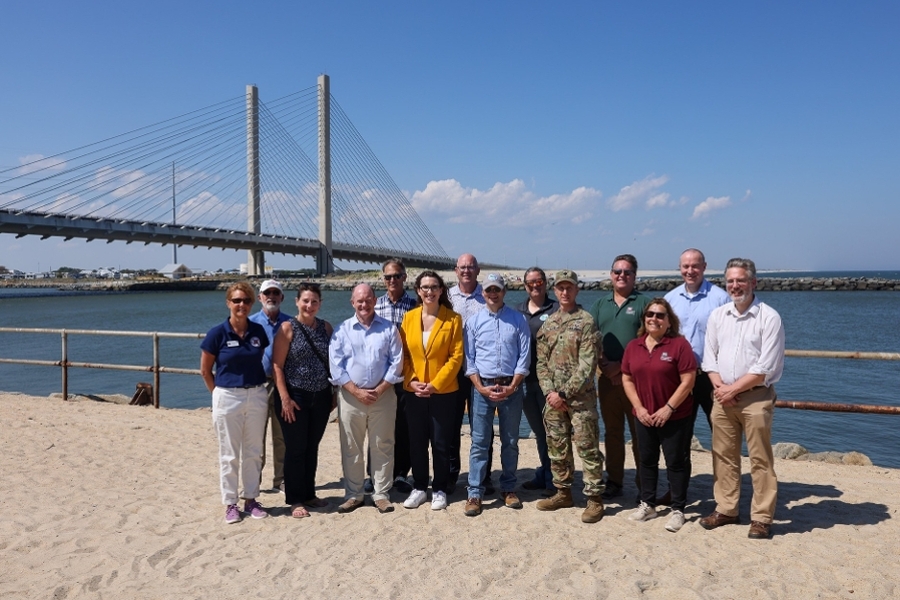Senator Coons, Congresswoman McBride Tour Beach Restoration Efforts

BETHANY BEACH, DE - On Friday, September 5, 2025, U.S. Senator Chris Coons and U.S. Representative Sarah McBride toured a series of U.S. Army Corps of Engineers projects at Delaware's Indian River Inlet Bridge and its surrounding beaches. They were joined by Lt. Col. Ryan Baum, commander of the Army Corps Philadelphia District, DNREC Secretary Greg Patterson, and other state and local officials.
The projects, which have received nearly $80 million in federal funding since 2022, are designed to protect the state's coastline from erosion and flooding. These initiatives aim to preserve the natural attractions vital to the state's economy and environment.
Between 2022 and 2024, Senator Coons helped secure over $30 million for coastal projects that are either underway or completed. The tour highlighted the inlet's new sand bypass system, which will help replenish beaches affected by erosion.
This system is being built with $1.2 million in Congressionally Directed Spending secured by the Delaware congressional delegation in 2022. The officials also visited a new project intended to reduce flooding during major storms, funded by $10 million in federal funding.
Similar projects in Fenwick Island, Rehoboth Beach, Dewey Beach, and Lewes have received over $24 million in federal funding since 2022 for dredging and beachfill efforts. An additional $43.8 million from the Bipartisan Infrastructure Law has been allocated for other coastline projects, including bulkhead and jetty repairs, as well as modeling and analysis.
"Delaware's incredible beaches are treasures of our state," said Senator Coons, co-chair of the Senate Climate Solutions Caucus. "We must protect this resource not just for the families that come here to make memories, but for the surrounding communities that are protected by our coastal areas from storms, flooding, and other disasters that are getting worse due to climate change. I'm proud to have secured $80 million in federal investment to restore and improve our beaches and will continue to work for more investment so these prized destinations are always here to be enjoyed."
"With Delaware being the lowest-lying state in the nation, we have no choice but to take coastal resilience seriously in our state," said U.S. Senator Lisa Blunt Rochester, a member of the Senate Environment and Public Works Committee. "From the Bipartisan Infrastructure Law to Congressionally Directed Spending - both of which I was proud to champion - I am pleased to see this significant federal funding being put to good use around the Indian River Inlet. I look forward to continuing to work with my federal, state, and local partners to pass a safer, healthier, and more resilient Delaware on to our future generations."
"Delaware's beaches aren't just part of our landscape - they're part of our economy, our identity, and our way of life," said Congresswoman McBride. "These federal investments help protect coastal communities from rising seas and severe storms, while supporting small businesses, preserving our environment, and keeping our tourism economy strong. I'm grateful for Senator Coons' leadership, and to have the opportunity to work alongside DNREC and our local leaders to deliver for Sussex County and safeguard our coastline for future generations."
"We have a long history of building and maintaining vital projects in the First State," said LTC Baum. "Teamwork is essential, especially with the dynamic and complicated forces at play here at the Indian River Inlet. We are fortunate to have a great team of engineers partnering with the state and others to enable success."
"This team of DNREC, the Corps of Engineers and the congressional delegation has worked well together over the last year to do beach nourishment on an expedited basis and to upgrade the sand bypass system and get it back up and running," said Secretary Patterson. "We know the challenges of this area aren't going away. With storms becoming more frequent and more severe, we must continue working together - across multiple levels of government and multiple agencies - to strengthen our coast, keep the inlet navigable and safeguard the communities and infrastructure that depend on it."

_1754575213489_1.jpg)